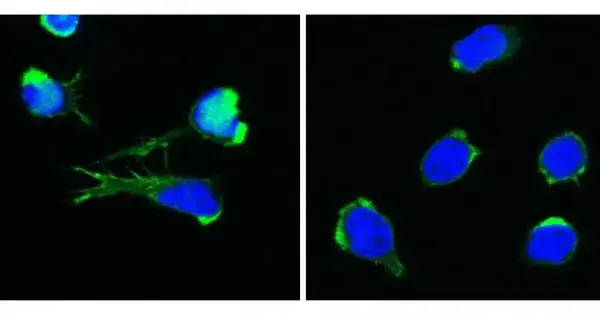Researchers from the St. Anna Children’s Cancer Research Institute, the CeMM Research Center for Molecular Medicine of the Austrian Academy of Sciences (AW), and the Medical University of Vienna have discovered a brand-new disease that links inflammation, immune system disruptions, and blood formation disruptions in their search for the cause of four children’s baffling symptoms. This discovery provides the foundation for a deeper comprehension of related diseases. The researchers’ recent publication in the New England Journal of Medicine marks a significant milestone.
A defect in the DOCK11 gene has been found to cause both white and red blood cell abnormalities. The fundamentals of blood formation and the immune system can be better understood with the help of such rare and previously unknown diseases. According to Kaan Boztug, senior author of the study and Scientific Director of St. Anna Children’s Cancer Research Institute (St. Anna CCRI), “they enable us to better understand the dysregulated processes underlying these diseases.”
The gene defect was first discovered in a young Spanish patient, and despite numerous tests, the severe inflammation affecting the kidneys, intestines, and skin could not be explained. Following the patient’s blood sample, the treating physician successfully contacted the St. Anna CCRI. The cause was discovered by the world’s leading center for rare diseases of the immune system and blood formation.
“Such rare and previously unknown diseases shed light on fundamental principles of blood formation and the immune system. They help us comprehend the dysregulated pathways that underpin many disorders.”
Kaan Boztug, senior author of the study and Scientific Director of St. Anna Children’s Cancer Research Institute.
According to Boztug, who is also a Professor in the field of Pediatrics and Inflammation Research at the Medical University of Vienna and an Adjunct Principal Investigator at the CeMM Research Center for Molecular Medicine of the Austrian Academy of Sciences, “we work closely with international partner institutions to understand such diseases and help the patients.”
Three additional patients with variants in the same gene The patient’s genome sequencing revealed a severe defect in the DOCK11 gene, which is involved in cell communication and had not previously been linked to any human disease.
“At first, we only had one patient, so we didn’t know which symptoms were caused by the gene defect and which were just additional manifestations that came with it. That was quite a challenge,” states Jana Block, the publication’s first author and Ph.D. student in Boztug’s group at St. Anna CCRI and CeMM. The researchers were able to locate additional patients with similar DOCK11 mutations as a result of their international collaborations, which contributed to a better understanding of the disease.
“At first, we only had one patient, so we didn’t know which symptoms were caused by the gene defect and which were just additional manifestations that came with it. That was quite a challenge,” says Jana Block, the publication’s first author and PhD student at St. Anna CCRI and CeMM who works in Boztug’s research group. Credit: One of the patients had a significantly decreased number of red blood cells, necessitating frequent blood transfusions, and the DOCK11 gene controls blood formation. Frailty frequently happens with invulnerable inadequacies, and frequently, an individual’s own red platelets are obliterated via autoantibodies that focus on their own platelets. However, this does not occur in healthy individuals, according to Jana Block. However, none of these autoantibodies were discovered during our investigations.
Using a zebrafish model, the researchers were able to determine the cause of the decreased number of red blood cells. A novel mechanism for anemia, or a lack of red blood cells, emerged as a result of the DOCK11 defect’s impaired blood cell formation.
DOCK11 regulates T cells; its function in humans was previously unknown. The protein was implicated in the development of B cells in mouse models in previous research. In humans with DOCK11 deficiency, the researchers have now demonstrated that T lymphocytes and other immune cells are overactivated at the same time and that B cells do not develop properly to some extent.
Block explains that the protein “seems to play a role in keeping the activation of T cells within a certain range.” This is important because, even when there isn’t a real pathogen, overactivation can damage the organs and tissues around it. In the case of DOCK11 deficiency, it is impossible to rule out the possibility of a link between T-cell defects and a predisposition to tumor diseases. According to Boztug, “We will certainly investigate this question further in our research.”
The researchers believe that blood-forming stem cell transplantation could cure the disease, despite the fact that not all aspects of DOCK11’s function are fully understood at this time.
“Obviously, these issues require investigation in subsequent studies. According to Boztug, gene therapy could also be used to treat DOCK11 deficiency.
The scientists place a very special significance on the fact that there is now hope for the creation of therapies: “We are aware that several of the patients have died from the disease,” Block states. “Our work over the past five years is undoubtedly a significant milestone.” The researcher hopes that the discovery of this gene mutation will spur further research into the disease at other institutions.
Boztug adds, “We see it as our mission not only to understand the biological processes but also to develop effective therapeutic strategies based on that because this disease is truly severe.”
More information: Systemic inflammation and normocytic anemia in DOCK11 deficiency, New England Journal of Medicine (2023). DOI: 10.1056/NEJMoa2210054





